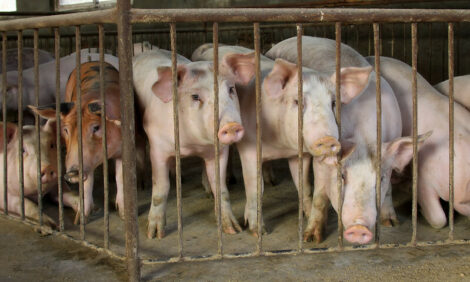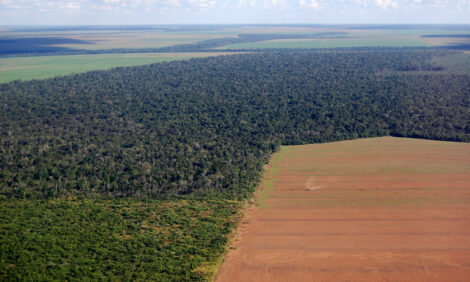



Moving biosecurity from the farm to the feed mill
An effective biosecurity strategy is not a stagnant process. It is continuously influenced by changes in pig-flows, disease pressures, virus evolution, emerging health issues and more. One such example is porcine epidemic diarrhea virus (PEDV). It presented many biosecurity lessons to the US pork industry, not the least of which is that feed, feed ingredients, processing and transportation require more attention.Watch the full interview or each part separately
Moving biosecurity from the farm to the feed mill
Part 2: Tracking a PEDV outbreak
Part 3: Risks from feed ingredients
“Feed mill biosecurity really occurred to us in the middle of PEDV breaks in the US,” Cassandra Jones, PhD, associate professor in animal sciences and industry at Kansas State University (KSU), told Pig Health Today. A team of researchers from KSU, South Dakota State and the Pipestone Veterinary Clinic, found that feed and ingredients can serve as a pathogen transmission reservoir.
They expanded their investigation into the mills and transportation vectors, such as truck tires and people associated with feed processing. “We’ve done a nice job to create fantastic biosecurity around the farm, but one of the weak points is that we continue to allow transport from feed mills to farms and back to mills,” she added. Jones is one of the members of KSU’s feed-safety research team, which includes veterinarians, swine nutritionists and feed scientists.
Now, with African swine fever (ASF) moving throughout the world and verification that the virus can survive in some feed ingredients, feed processing needs to be part of the biosecurity discussion.
A risk-based approach
There are literally a lot of moving parts in a feed mill and the manufacturing process and because biosecurity protocols were essentially non-existent, getting started means taking a risk-based approach. “We started by doing environmental sampling to gain a better understanding of where in the feed mills might present the highest risk for virus contamination,” Jones said.
Not surprisingly, workers, specifically their shoes, presented the biggest contamination risk. As Jones pointed out, biosecurity training or expectations for feed mill workers haven’t matched those for hog farm workers. “Even if it’s a grow/finish barn, workers are expected to wash or change boots,” she added.
Some mills she works with have now established areas for employees to wash or sanitize their shoes. Others are applying sanitizing solutions on floors to try to minimize high risk areas. “Some of our partners are showering into feed mills,” Jones noted. “In some cases, the biosecurity to get into feed mills is as high as it is to enter farms.”
She also cited particularly progressive production systems that are starting to put in Danish bench-entry systems into their feed mills like those used in sow farms. “Where you have a bench to sit on to take your outside shoes off, then swing your feet over to the other side and put on clean shoes that you only use in the feed mill,” Jones said.
Deciding which steps to take depends on the risk of the pathogen. Right now, the objective is to get people thinking about feed mill biosecurity.
“It gets complicated in a hurry. Once a pathogen gets into a feed mill, it’s hard to decontaminate it,” Jones relayed, based on her own research findings. “It’s important to keep the mill clean.”
Ingredients vs trucks
Following the important research that revealed some feed and feed ingredients can harbor some swine viruses, the focus has been on eliminating high-risk ingredients. But what are those exactly?
“There’s no short answer to that,” Jones said. “It comes down to a number of factors.” Such as, what is the product; where does it come from; how it was handled, manufactured and shipped? It’s really about quality control and biosecurity of the parties involved. Ask questions and go through the process to learn more about the ingredients.
“We know we can’t eliminate all products from countries with ASF,” she said. “Arguably, a lot of products are actually safe.” While she noted that some products like rice or soy hulls or corn cob carriers, depending on the country could be relatively high-risk. But fermented amino acids or vitamins that are produced in biosecure laboratories that are third-party inspected and verified; if those products are in a sealed package – she’s pretty comfortable with those. However, if those same products are shipped in a tote bag, vessel or truck without details about products previously transported, that presents a higher risk.
Again, prioritizing what to address here at home, environmental sampling and feed trucks need more attention. With a recent PEDV break on a KSU farm, Jones used environmental sampling to train farm employees about critical biosecurity procedures but also to track the virus so they could “walk it off the farm,” she noted. “More importantly we kept the feed mill and an off-site nursery clean.”
The key was changing how they used their feed trucks. Although KSU had two feed trucks, they used one more often, moving from swine farms to the feed mill and back multiple times a week. To minimize contamination, they designated one truck to remain inside a farm’s perimeter, while a truck designated to the feed mill delivered feed over a fence line into the farm’s truck. The KSU researchers swabbed the feed mill truck, keeping it away from the mill until tests came back negative.
Jones noted that overall, the truck swabs revealed that “it’s not necessarily that the feed or ingredients were a disease risk; it’s the truck itself – the tires, the foot pedals and the step to get in and out of the truck became the biggest risk to carry PEDV.”
Tap available resources
Feed mill biosecurity concepts are new and can be a lot to process, but there are resources available. KSU has made volumes of information available on its feed website, including how to conduct and interpret environmental sampling, a biosecurity checklist and how to perform biosecurity audits.
“Hopefully, as we help feed mills, feed facilities and farms better understand their risks, they can make more data-based decisions and tackle the highest priority items,” Jones said.
At the same time, don’t overlook the veterinarian’s role in coordinating biosecurity with the swine nutritionist, feed mill and others involved in the production system, particularly those involved with the procurement program. “Make sure those parties are married together and making the correct, risk-based decisions,” she concluded.






